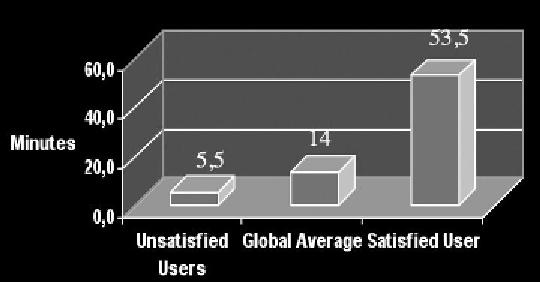Graphics Programs Reference
In-Depth Information
Figure 1. Collaboration in virtual learning environments could sustain students' attention on a single
topic for one hour, on average
The scrolls are documents that either represent
a very ancient (often the most ancient) copy of
a book of the Bible, or describe features of the
life and belief of this sect, living near the Dead
Sea, roughly from the second century B.C. to
the first century A.D. Targets for the educational
collaborative experience were students of junior
and senior high-schools.
The approach we were required to follow was
to apply leverage to the potential of 3D learning
environments to create a new methodology of
learning, based on cooperation, competition, shar-
ing of knowledge between pairs and interaction.
Prior to use the 3D learning environment and
meet other classes in the virtual space, each class
was required to prepare specific topics with the
assistance of their teachers. Then the students
connected to the system and started working with
other classes, using the computer laboratories of
their schools and thus collaborating also with each
other, “at their side” of the connection.
In order to build an effective and reliable en-
vironment, the developing team decided to rely
upon web-based “industrialized building blocks”,
and the preference was for Macromedia Flash,
Shockwave and Director (Barbieri et al., 2004).
The choice was mainly determined by the need
of having a reliable technology provider (after a
few “bruising experiences” with VRML engines
coming in and out of the market) and wide avail-
ability (with no additional cost for the users).
The resulting environment was named WebTalk3
(
WebTalkCube
) (Figure 2). The 3D world was
based upon the 3D model generated by one of
the commercial 3D design tools such as Discreet
3D, Studio Max, Lightwave 3D, etc.
Once the 3D model was complete, it was ex-
ported (as a monolithic entity that was not pos-
sible to split into modules), in Shockwave 3D
(W3D), a file format, suitable to be understood
by Macromedia applications. The programmer
had to import everything into the Director's stage
and only then all the dynamic aspects (including
“behaviors” of the interactive objects, the events
to which to react, etc.) could be hard coded. Even
changing position to one object or a colour change,
forced the programmer to ask the designer to make
the changes then re-export the geometries, prob-
lems similar to the ones we already had in
WebTalk-1. Furthermore the development process
(including the fact that the “names” within the
two environments, the modelling one and the
Director, had to be exactly the same) was cumber-
some, confusing and expensive (e.g. the Director
of the programmers had to learn 3D Studio Max).
Despite these problems, SEE and its underly-
ing software system WebTalk3, were successfully
deployed and in two years more than 70 schools

Search WWH ::

Custom Search